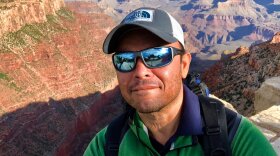Forty-nine years ago tomorrow, Apollo astronauts landed on the Moon. But first they came to Flagstaff to train. Friday night the city is launching a yearlong celebration of Flagstaff’s role in the lunar missions. KNAU’s Melissa Sevigny spoke with local geologist and historian Rich Kozak about that legacy.
So if I understand correctly, every astronaut that walked on the Moon, first came here to Flagstaff to train. Is that right?
That’s correct. The back story to that goes back to the late 1940s. That’s when a fellow named Eugene Shoemaker was studying volcanic features on the Colorado Plateau. Some of these are quite explosive in their nature, so they would form small crater-like features…. He proposed to the U.S. Geological Survey that they should have a program in planetary or at least lunar geology.
What is it about Flagstaff that made it the right place to train for the Moon?
Well, on the Colorado Plateau you don’t have much vegetation. The geology’s just there for everybody to see. It made it an ideal place to learn or teach geology. And of course we’ve Meteor Crater, which is the world’s first best meteor crater. In fact, the very first trip out here by astronauts was to Meteor Crater and Sunset Crater. And that demonstrated to NASA the value of actually training the astronauts in geology.
There was also a component of this that was like physical training, they had to get into their astronaut suits and drive the moon buggy around?
Most of what was done as far as learning the actual lunar rover, being in the suits, using the actual instruments, was actually done back at the Cape or Houston. A lot of what you see here in films or photos around Flagstaff are actually geologists that would get suited up and go through the motions. The astronauts’ time was booked, so they didn’t have a lot of time to be learning this process, and that’s what Flagstaff was about: how do you do field geology on another planet, one with a very hostile environment?
That’s fascinating! So that begs the question, why not just send geologists to the Moon?
Given that there was billions and billions of dollars at stake, and the national prestige of the United States at stake here, it’s understandable why they did go ahead and send trained experienced test pilots to the Moon. …. There’s a quote I love from Eugene Cernan, the commander of Apollo 17. He said, “All the geology training in the world isn’t going to matter one bit if you don’t get there.”
What do you think has been the legacy of the Apollo era?
For me, I think it’s—I don’t want to say lost on people—but just the fact that it’s not a part of their experience to have lived in a time when mankind had not left the earth. We take that as history and history tends to be old and dusty and boring, but the fact of the matter is, two-thirds of the people alive today were born after the Apollo moon landings. For them it is history. To think that in 4 or 4 plus billion years of Earth’s history, this was the first and always will be the first time when mankind left the Earth, I find that so profound. And the fact that Flagstaff was so central to mankind’s leaving the Earth and mapping other planets …. It’s too much to comprehend, it’s too big to really take it all in.
Rich, thank you so much for joining me today.
You’re welcome, thank you.
Flagstaff’s Lunar Legacy celebration launches 5pm Friday night at the Orpheum Theater. You can find more information at www.flagstafflunarlegacy.com








